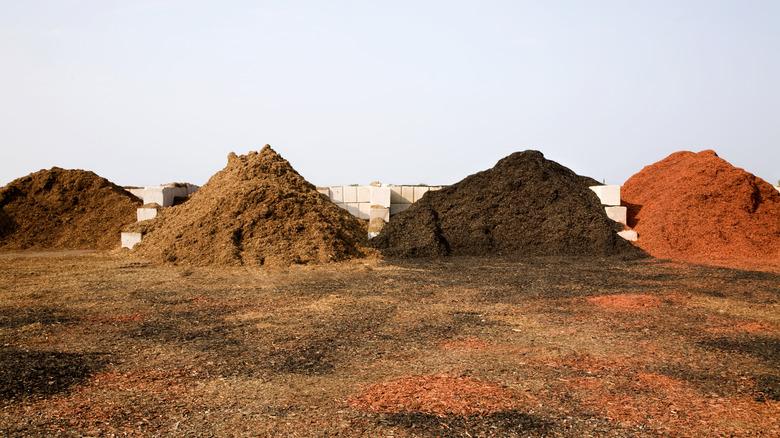The Outdated Mulch Color To Avoid Using In Your Yard (And What To Do Instead)
While interior design remains a solid member of the zeitgeist, landscaping and outdoor trends are not quite as widely talked about. But everything from exterior finishes to landscaping choices can make a big impact on the appearance of your home — including the wrong color of mulch. Yes, believe it or not, your choice in mulch can be enough to make your home look like it's in need of an update — which can be an even bigger issue if you are looking for landscaping ideas that will boost curb appeal and sell your home. Though beauty is in the eye of the beholder, it is pretty universally acknowledged at this point that red mulch is and should be a thing of the past.
If you aren't much of a landscaper, you may not be fully informed on all of the mulch options out there, but there are actually quite a few choices to be had in both appearance and makeup. There is organic mulch (made from plant materials such as wood chips and leaves) and inorganic mulch (made with harder, non-biodegradable materials like shells, rocks, glass or stone). They also differ in the effect on surrounding plant life. Organic mulch — while serving as a ground cover — is also aimed at improving the soil structure and nutrients. Inorganic mulch is better at blocking weed growth in the short term, and can be a safer option in fire-prone regions, but it can also negatively effect the microbiome of the soil. The choice of dyed mulches is purely aesthetic, so there is no reason to choose a red mulch over another dyed color other than preference. Let's dig further into the other reasons why red mulch may be a mistake.
Why red mulch is a red flag
Most red mulch technically belongs in the organic category as it is made from chipped wood, but the visual effect is far from it. It generally gets its bright red color from natural dyes like iron oxide (though cheaper brands may use toxic dyes), which is technically harmless to the environment. Aesthetically, it creates a stark contrasting effect next to grass and other greenery — its complement on the color wheel. The iron oxide-infused color also tends to be fade-resistant, so if you would like to swap out your mulch color, you will be forced to do some heavy raking before you replace it, or there is a good chance it will end up showing through. Because it is so dissimilar from most other surrounding, naturally-occurring colors, it also demands more maintenance. Fallen leaves and plant debris stand out against these solid colors instead of blending like they do with more organically colored mulches, so you will be forced to tend regularly to your mulched areas if you want them to stay pristine.
Not only is red mulch not the most sophisticated when it comes to gardening, but it, along with other dyed mulches, is not necessarily the healthiest option. Many dyed mulches are made from recycled wood, and while "the three Rs" (reduce, reuse, recycle) is a great mantra to live by, it has its caveats. The issue comes down to where the wood was sourced. Many recycled mulches contain treated wood, the weather-resistant treatment which often includes heavy metals such as copper, aluminum, arsenic, and lead, which can be harmful not only to your plant life, but more importantly, the surrounding water supply.
How to choose the right mulch for you
When choosing your mulch, you will want to consider both how it will look and how it will impact the environment around you. As far as quality, look for stickers of approval from the Mulch and Soil Council (MSC) as this certifies that the mulch has been tested to be sure that it does not contain certain harmful ingredients.This mainly refers to toxic dyes and heavy metals. It does not however test for presence of pesticides. In order to properly mulch your landscape, you also want to choose a material that complements the environmental conditions of your location. When in doubt, however, organic, un-dyed, shredded or chipped wood is one of the most cost-effective and universally successful options out there.
As far as choosing the best type of mulch for an updated look, an almost fool-proof choice is natural cedar chips. It is one of the longest-lasting wood mulches as well as being naturally rot-resistant. Unlike dyed mulches, cedar mulch is also generally made directly from trees, so you can be sure that you are investing in a chemical-free and long-lasting solution. Though it starts as a light golden yellow, it eventually fades to a neutral gray — both of which look great in any garden. Earning extra brownie points, it also gives off a pleasant piney fragrance.


